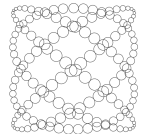Welcome to this week’s Math Munch!
As Justin mentioned last week, the Math Munch team had a blast at the MOVES conference last week. I met so many lovely mathematicians and learned a whole lot of cool math. Let me introduce you to Carolyn Yackel. She’s a math professor at Mercer University in Georgia, and she’s also a mathematical fiber artist who specializes in the beautiful Temari balls you can see below or by clicking the link. Carolyn has exhibited at the Bridges conference, naturally, and her 2012 Bridges page contains an artist statement and some explanation of her art.
 |
 |
 |
Temari is an ancient form of japanese folk art. These embroidered balls feature various spherical symmetries, and part of Carolyn’s work has been figure out how to create and exploit these symmetries on the sphere. I mean how do you actually make it that symmetric? Can you see in the pictures above how the symmetry of the Temari balls mimic the Archimedean solids? Carolyn has even written about using Temari to teach mathematics, some of which you can read here, if you like.
Read Carolyn Yackel’s Q&A with Math Munch.
Up next, you may remember Edmund Harriss from this post, and you might recall Desmos from this post. Well the two have come together! On his blog, Maxwell’s Demon, Edmund shared a whole bunch of interactive graphs from Desmos, in a post he called “Form Follows Function.” Click on the link to read the article, and click on the images to get graphs full of sliders you can move to alter the images. In fact, you can even alter the equations that generate them, so dig in, play some, and see what you can figure out.
 |
 |
 |
Finally, I want to share a piece of music I really love. “Clapping Music” was written by Steve Reich in 1972. It is considered minimalist music, perhaps because it features two performers doing nothing but clapping. If you watch this performance of “Clapping Music” first (and I suggest you do) it might just sound like a bunch of jumbled clapping. But the clapping is actually built out of some very simple and lovely mathematical patterns. Watch the video below and you’ll see what I mean.
Did you see the symmetries in the video? I noticed that even though the pattern shifts, it’s always the same backwards as forwards. And I also noticed that the whole piece is kind of the same forwards and backwards, because of the way that the pattern lines back up with itself. Watch again and see if you get what I mean.
Bonus: Math teacher, Greg Hitt tweeted me about “Clapping Music” and shared this amazing performance by six bounce jugglers!!! It’s cool how you can really see the patterns in the live performance.
I hope you find something you love and dig in. Bon appetit!





Pingback: Los patrones matemáticos de “Clapping Music” | :: ZTFNews.org
Pingback: TesselManiac, Zeno’s Paradox, and Platonic Realms | Math Munch
what are the symbols on the screen mean?
Which symbols do you mean, Marina?
the picture on the screen of the video
Oh! Well the red bar shows the clapping pattern.
3 claps, then a break, then 2 claps, then a break, then 1, a break, then 2 more. At first they clap together and then one of the pattern shifts.
Every circle is a clap. When the red bar passes over a circle, there’s a clap. Make more sense?
I like the how the pattern keeps continuing and with the two matching to the three it makes a cool design with the rest of the pattern.
Where do you get the patterns? Did he just make them up or is there a specific meaning to them? I think it’s very cool how the patten keeps on going and never does more than 3 claps in a row. Why is that? Thanks for posting this video!
The clapping pattern is very cool, and would it work to make a different pattern of claps on the blue strip and still get the same effect? For example adding in 4 dots on the blue so it makes the pattern 1-2-3-4 claps?
What i really liked about this video was how after a while the pattern of the clapping started to get more complex. Towards the end it sounded like a lot of people were clapping at the same time, but this was only recorded with two people clapping right? If so that pretty cool. To change the placement of the clapping, a computer software was used, correct? I thought the tune was very nice!
The fact that the red pattern never changed and it was the blue pattern aligning with each change was my favorite part. it shows that you don’t need to have 2 entirely new patterns every time to get a unique sound
Fun I noticed the red line always ended on the red line with the dots on it is there a reason for that. I liked all of the patterns and sounds of the clapping
I noticed that it was always three claps, two claps, one clap, and then two again never different the first one was my favorite because it was simple and plane.
I really enjoyed watching the clapping video it was very entertaining hearing the change of beat and different claps put together to make a rhythm. I also saw that the way that they explained how the beat of the clapping as it is forward is also the same backwards.
It seems like this would take so much practice, but since there is symmetry in the two patterns it probably was easy to get. I didn’t see that the patterns were the same forwards and backwards at first but when I watched it again I noticed.
I thought this kind of rhythm would be sloppy, but I was wrong. It’s hard to know for sure what it’ll really sound like until you actually listen to it.
Pingback: Havel-Hakimi, Temari, and more GIFS | Math Munch
Pingback: Harriss Spiral, Math Snacks, and SET | Math Munch
At first I was like how is this music? Then when I listened really closely I heard the individual claps and the rhythm. I loved how the music kept on getting more and more complex. I would never be able to clap that fast!!! 🙂 That for posting it!
Reblogged this on Math Munch and commented:
We have a rare 5 Thursdays this month, so we get an extra rerun post. This one features a Q&A with mathematical artist Carolyn Yackel and much more beautiful stuff. Enjoy!